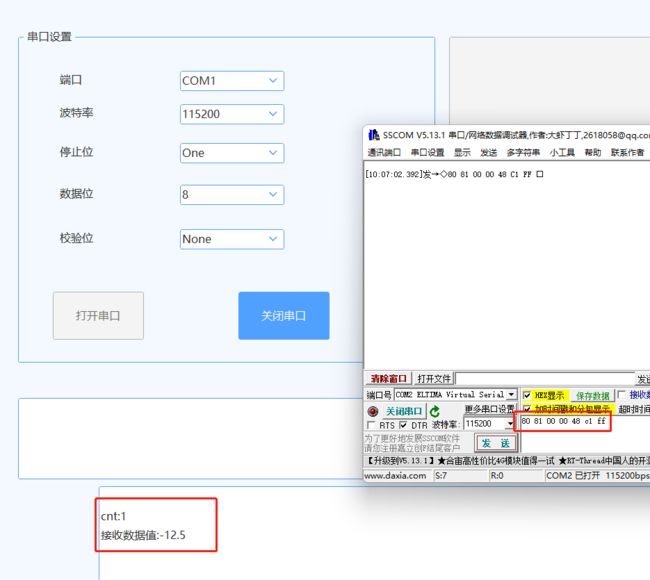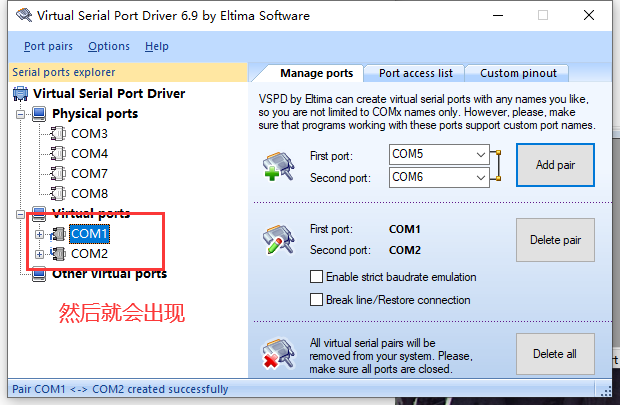c# 与单片机之间 float与byte的相互转化
该章作为 串口调试助手及结构体的收发的补充,主要用于自定义协议中的负数,浮点数等的收发(我们以前用的浮点数等,是直接使用的字符串的收发,从字符串中进行解析的,这里主要使用十六进制,对其收发原理及使用操作进行剖析)。
虚拟串口调试助手
一般来说,电脑的外部设备可以用过各种端口和电脑连接。常见的有USB,VGA,DVI等等。在工业领域或者是软件开发领域,我们常常需要用简单低成本快捷的方式,完成电脑和设备的连接。那么串口就是非常好的选择
在开发阶段,也许设备端也许还没有就绪,PC软件需要先进行开发,我们就可以通过软件虚拟一个串口出来。用来替代设备的实体。供学习使用
字节与数据转换
c# 实现
using System.Runtime.CompilerServices;
namespace ConsoleApp1
{
internal class Program
{
static void Main(string[] args)
{
byte[] dataByte = new byte[120];
int count = 0;
//将double型数据存入databyte中。
double data1 = -123.125;
//C# BitConverter 类用来字节数组转换 可以转换成字节 也可以字节转换成int、double等
byte[] buf = BitConverter.GetBytes((double)data1);//单精度浮点型用 BitConverter.ToSingle
Console.WriteLine(BitConverter.ToDouble(buf));
}
}
}
c 实现
#include 实践
与串口调试助手
其中头两个字节,尾一个字节,中间数据4个字节,使用的是c语言转换过来的单精度4字节 可见上面c实现

public static int cnt = 0;
private void serialPort1_DataReceived2(object sender, System.IO.Ports.SerialDataReceivedEventArgs e)
{
cnt++;
this.Invoke((EventHandler)delegate
{
uiRichTextBox1.AppendText("\r\n" + "cnt:" + cnt);
});
Thread.Sleep(40);
int len = serialPort1.BytesToRead;//一共接收到多少数据
Byte[] readBuffer = new Byte[100];
serialPort1.Read(readBuffer, 0, len);
//2+4+1 80 81 0 0 48 c1 ff 就是-12.5
//获得一帧掐头去尾的数据
for (int ptr = 0; ptr < len; ptr++)
{
if ((readBuffer[ptr] == HEAD1) && (readBuffer[ptr + 1] == HEAD2))
{
if (readBuffer[ptr + 6] == 0xff)
{
int index = ptr + 2;
byte[] fdata = new byte[4];
for (int i = 0; i < 4; i++)//这样就把尾巴给去掉了
{
fdata[i] = readBuffer[index + i];
}
this.Invoke((EventHandler)delegate
{
uiRichTextBox1.AppendText("\r\n" + "接收数据值:" + BitConverter.ToSingle(fdata,0).ToString());
});
}
}
}
}
c# 接收浮点型数据
//直接调用ReadDate函数,接收到的数据会自动保存入 ushort[] value1 中
//一个ushort占用两个字节,一共接收到2个ushort,共四个字节
//调用GetFloat即可实现转换
public static void ReadDate()
{
ushort startAddress = 0x0066;
ushort numberOfPoints = 2;
ushort[] value1 = master.ReadHoldingRegisters(1, startAddress, numberOfPoints);
log.SaveLog("value1字节数:"+value1.Length.ToString());
float valuefloat;
valuefloat = GetFloat(value1[0], value1[1]);
log.SaveLog("流量" + valuefloat);
}
public static float GetFloat(ushort P1, ushort P2)
{
int intSign, intSignRest, intExponent, intExponentRest;
float faResult, faDigit;
intSign = P1 / 32768;
intSignRest = P1 % 32768;
intExponent = intSignRest / 128;
intExponentRest = intSignRest % 128;
faDigit = (float)(intExponentRest * 65536 + P2) / 8388608;
faResult = (float)Math.Pow(-1, intSign) * (float)Math.Pow(2, intExponent - 127) * (faDigit + 1);
return faResult;
}




